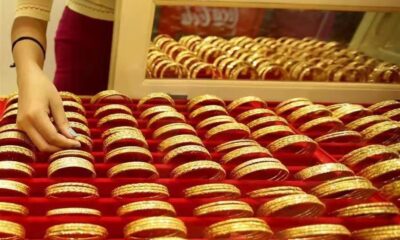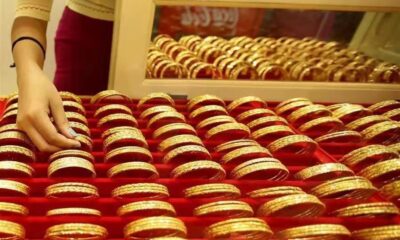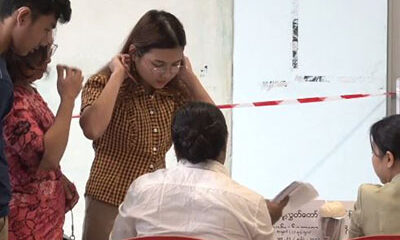Culture & Entertainment
မြန်မာနိုင်ငံ၏ ပျောက်ကွယ်လုနီးပါး သားရေခွာရုပ်လုံးသွင်းပညာကို လက်ဆင့်ကမ်းထိန်းသိမ်းရန် မျိုးဆက်သစ်များကို ဖိတ်ခေါ်
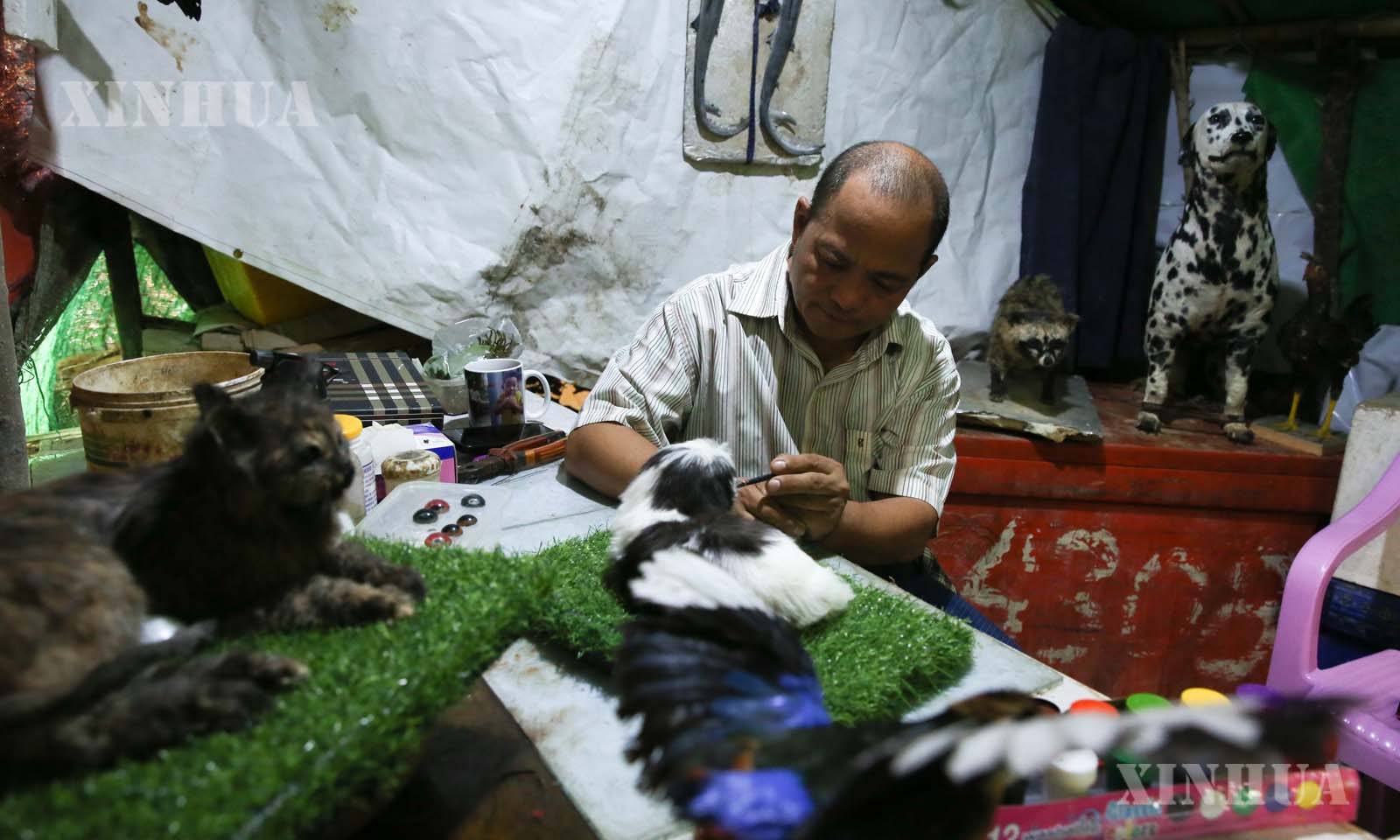
ရန်ကုန်၊ ဩဂုတ် ၁၉ ရက် (ဆင်ဟွာ)
ရန်ကုန်မြို့၏ တိတ်ဆိတ်သောနေရာ၊ ပျားပန်းခပ်မျှရှုပ်ထွေးလှသောလမ်းများကြားက ရိုးရိုးရှင်းရှင်း တဲလေးတစ်ခုတွင် သားရေခွာရုပ်လုံးသွင်း၍ သက်ရှိကဲ့သို့ ပြုပြင်ထိန်းသိမ်းမည့် သက်မဲ့တိရစ္ဆာန်လေးများဖြင့် ပြည့်နှက်နေသည်။ ထိုနေရာလေးသည် ရုပ်လုံးသွင်းပညာရပ်ကို လုပ်ကိုင်နေသည်မှာ သက်တမ်း ၂၅ နှစ်ကျော်ကြာပြီဖြစ်သော၊ မြန်မာနိုင်ငံ၏ သားရေခွာရုပ်လုံးသွင်းပညာရှင်အနည်းငယ်အနက် တစ်ဦးဖြစ်သည့် အသက် ၅၂ နှစ်အရွယ် ဦးမျိုးနိုင်၏ လုပ်ငန်းခွင်နေရာပင်ဖြစ်သည်။
“သားရေခွာရုပ်လုံးသွင်းပညာရပ်ဆိုတာ သေဆုံးသွားတဲ့ တိရစ္ဆာန်တွေကို အရေခွံခွာ အချောကိုင် ပြန်လည်သန့်စင်တဲ့အနုပညာဖြစ်ပါတယ်။ ကျွန်တော်က ဒီပညာရပ်ကို ဆရာကြီး ဦးဘော်သန်းဆီကနေ သင်ယူလေ့လာခဲ့တာပါ” ဟု ဦးမျိုးနိုင်က ဆိုသည်။
“မြန်မာနိုင်ငံမှာ သားရေခွာရုပ်လုံးသွင်းပညာရပ်က လုပ်ကိုင်တဲ့သူ ရှားပါးပြီးတော့ ပျောက်ကွယ်လုနီးပါးဖြစ်နေတဲ့ ပညာရပ်တစ်ခု ဖြစ်ပါတယ်။ နောက်မျိုးဆက်သစ်တွေဆီ ဒီပညာအမွေလေး လက်ဆင့်ကမ်းပေးချင်တဲ့အတွက် ကျွန်တော်က ဆက်ပြီး လေ့လာလုပ်ကိုင်နေတာဖြစ်ပါတယ်။ ကျွန်တော်တို့နိုင်ငံမှာ ဒီပညာရပ်ကို ထိန်းသိမ်းထားချင်ပါတယ်” ဟု ဦးမျိုးနိုင်က ပြောသည်။
“ဒီရုပ်လုံးသွင်းပညာရပ်ကို လေ့လာလိုတဲ့ ဝါသနာရှင်တွေကိုဖိတ်ခေါ်ပါတယ်။ ဒီပညာရပ်ကို လေ့လာကြတဲ့ လူတချို့ကတော့ ပြီးဆုံးတိုင်အောင်မသင်ကြဘူး။ အများစုက ဝါသနာလည်းရှိလို့ သင်ကြားလေ့လာကြတာ ဒါနဲ့အသက်မွေးဖို့တော့ မဟုတ်ကြဘူး။ ဒါကြောင့် ဒီလိုရှားပါးတဲ့ပညာရပ်ကို မျိုးဆက်သစ်တွေ ဆက်လက်ထိန်းသိမ်းကြဖို့ လိုပါတယ်” ဟု ၎င်း၏ အမြင်ကို ပြောခဲ့သည်။
သေဆုံးသွားသော တိရစ္ဆာန်များကို သားရေခွာရုပ်လုံးသွင်းပညာရပ်အား လေ့လာနေသည်မှာ လေးနှစ်ကျော်ရှိပြီဖြစ်သော ကိုဖြိုးအာကာက ယခုပညာရပ်ရှိခြင်းက ရှားပါးတောရိုင်းတိရစ္ဆာန်လေးများ၊ တိရစ္ဆာန်ချစ်သူများအနေဖြင့် ၎င်းတို့ချစ်ခင်နှစ်သက်သော တိရစ္ဆာန်လေးများ သေဆုံးသွားလျှင်ပင် သက်ရှိပုံလေးအတိုင်း မြင်တွေ့နိုင်ကြောင်း၊ ထိုပညာရပ်က တိရစ္ဆာန်ချစ်သူများအတွက် လွန်စွာအကျိုးရှိကြောင်း ပြောခဲ့သည်။
သားရေခွာရုပ်လုံးသွင်းပညာရပ်ကို အချိန် တစ်လခန့်ကြာ လေ့လာခဲ့သော ကိုပြည့်ကလည်း “ဒီပညာရပ်ကို စိတ်ဝင်စားပေမဲ့ ဒီလုပ်ငန်းနဲ့အသက်မွေးဖို့တော့ အစီအစဉ်မရှိသေးပါဘူး။ ဒါက တိရစ္ဆာန်ချစ်သူတွေကို ကူညီနိုင်မယ့် နည်းလမ်းတချို့လို့ ထင်ပါတယ်” ဟု ဆိုသည်။
ရုပ်လုံးသွင်းပညာရှင် ဦးမျိုးနိုင်က “တစ်လကို သားရေခွာရုပ်လုံးသွင်းဖို့ နှစ်ကောင်၊ သုံးကောင်၊ လေးကောင်ဝန်းကျင်လောက်လုပ်ရပါတယ်။ တစ်ခါတစ်လေတော့ မရှိတာမျိုးလည်း ရှိပါတယ်။ ခန့်မှန်းလို့မရပါဘူး။ အနာဂတ်မျိုးဆက်တွေ ဒီပညာရပ်ကို ထိန်းသိမ်းစေချင်တဲ့အတွက် ဒီအလုပ်ကို ကျွန်တော်ဆက်ပြီးလုပ်နေတာပါ” ဟု ဖြည့်စွက်ပြောခဲ့သည်။
“လက်ရှိ မြန်မာနိုင်ငံမှာတော့ သားရေခွာရုပ်လုံးသွင်းပညာလုပ်ငန်းကို လုပ်ကိုင်နေတာ ဆရာကြီး ဦးဘော်သန်းရယ် ကျွန်တော်ရယ် နှစ်ယောက်ပဲရှိပါတယ်။ တက္ကသိုလ်တွေမှာ ဒီပညာရပ်နဲ့ပတ်သက်ပြီး ကျွန်တော်သင်ကြားပေးထားတာတွေ ရှိပါတယ်။ ဒီလိုခက်ခဲတဲ့ပညာရပ်ကို ထိန်းသိမ်းဖို့ ဝါသနာရှင်တွေကိုလည်း တိုက်တွန်းအားပေးပါတယ်” ဟု ၎င်းက ပြောခဲ့သည်။ (Xinhua)
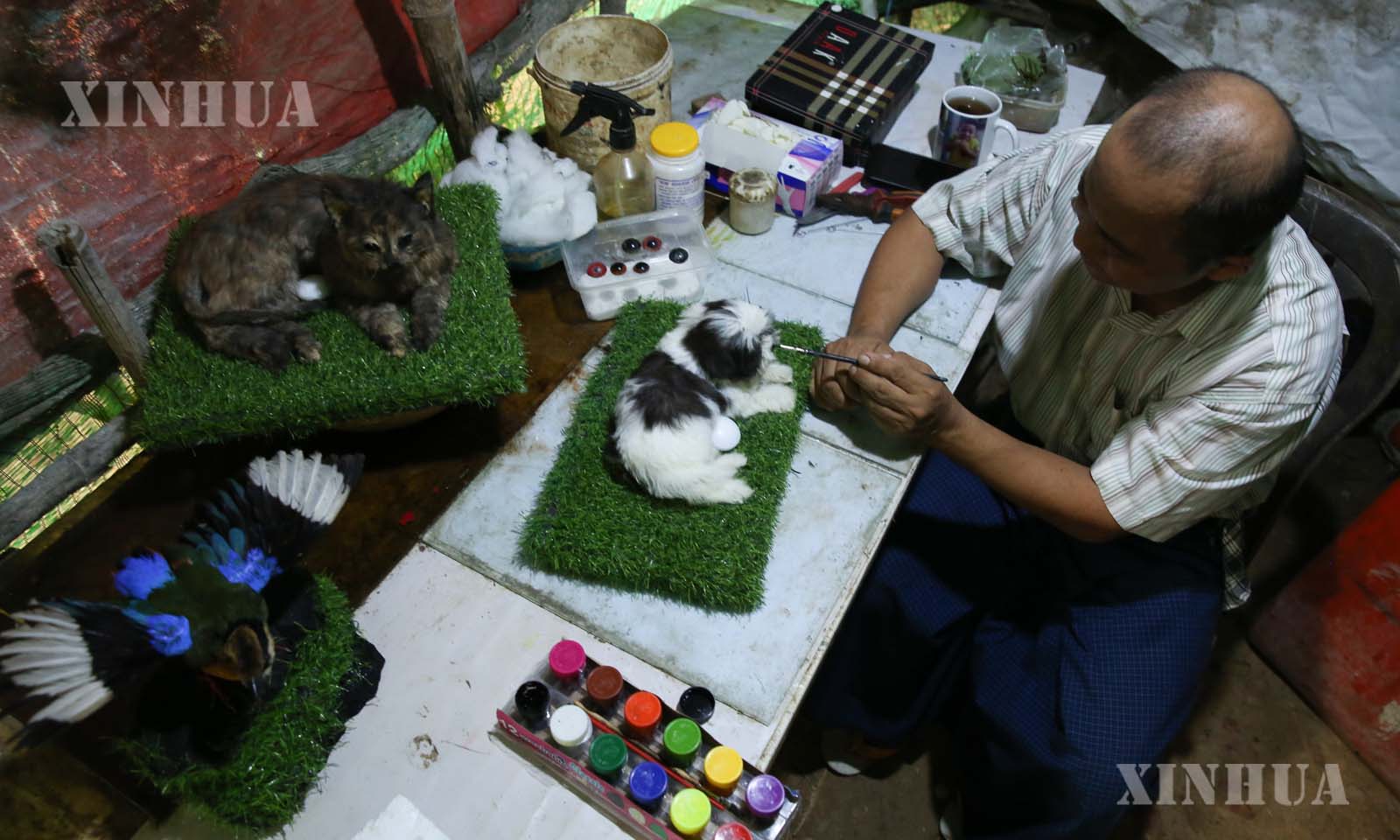
မြန်မာနိုင်ငံ ရန်ကုန်မြို့ရှိ သားရေခွာရုပ်လုံးသွင်းပညာရှင် ဦးမျိုးနိုင်ကို ၎င်း၏အလုပ်ရုံတွင် ၂၀၂၄ ခုနှစ် ဩဂုတ် ၁၈ ရက်က တွေ့ရစဉ် (ဆင်ဟွာ)
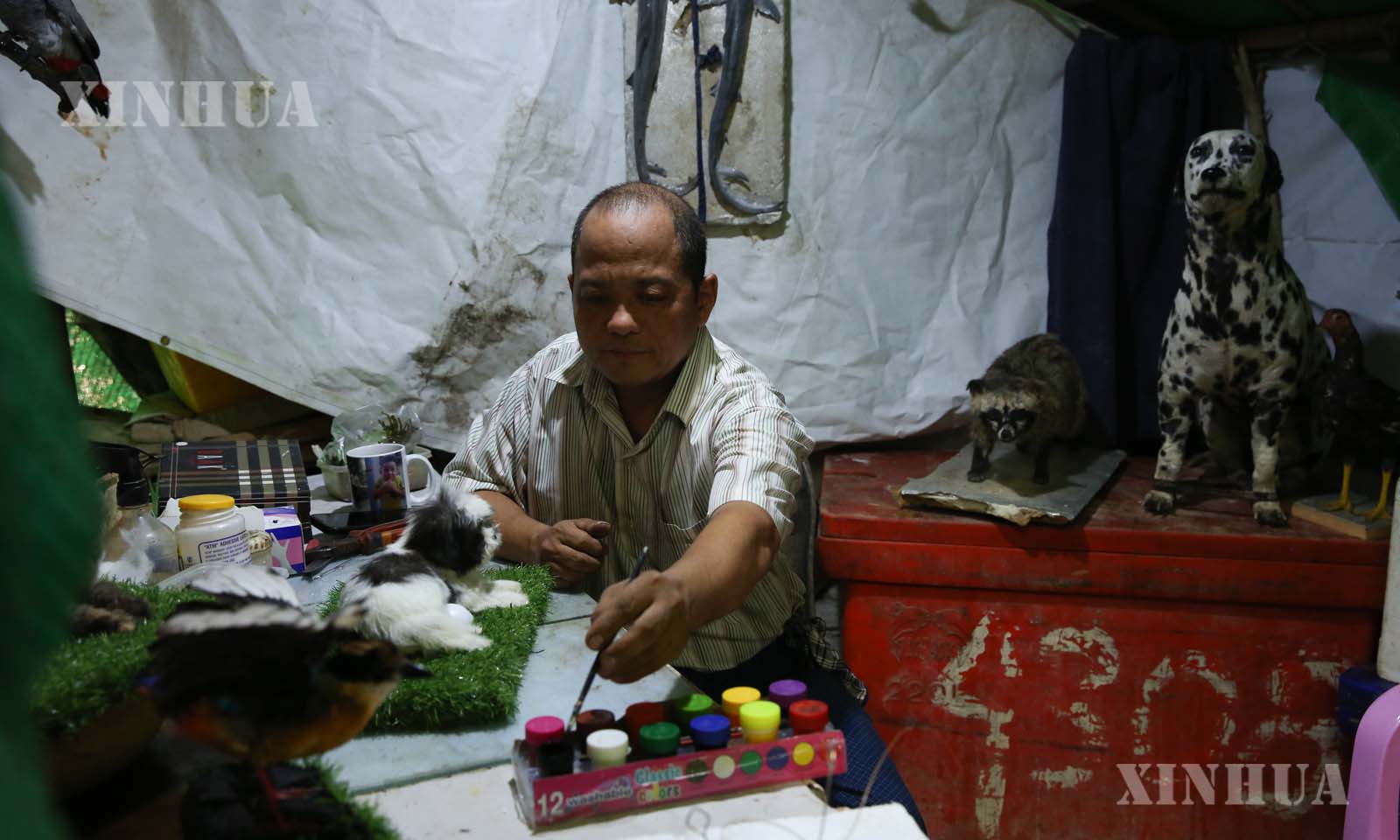
မြန်မာနိုင်ငံ ရန်ကုန်မြို့ရှိ သားရေခွာရုပ်လုံးသွင်းပညာရှင် ဦးမျိုးနိုင်ကို ၎င်း၏အလုပ်ရုံတွင် ၂၀၂၄ ခုနှစ် ဩဂုတ် ၁၈ ရက်က တွေ့ရစဉ် (ဆင်ဟွာ)

မြန်မာနိုင်ငံ ရန်ကုန်မြို့ရှိ သားရေခွာရုပ်လုံးသွင်းအလုပ်ရုံတွင် ရုပ်လုံးသွင်းထားသော တိရစ္ဆာန်လေးများကို ၂၀၂၄ ခုနှစ် ဩဂုတ် ၁၈ ရက်က တွေ့ရစဉ် (ဆင်ဟွာ)
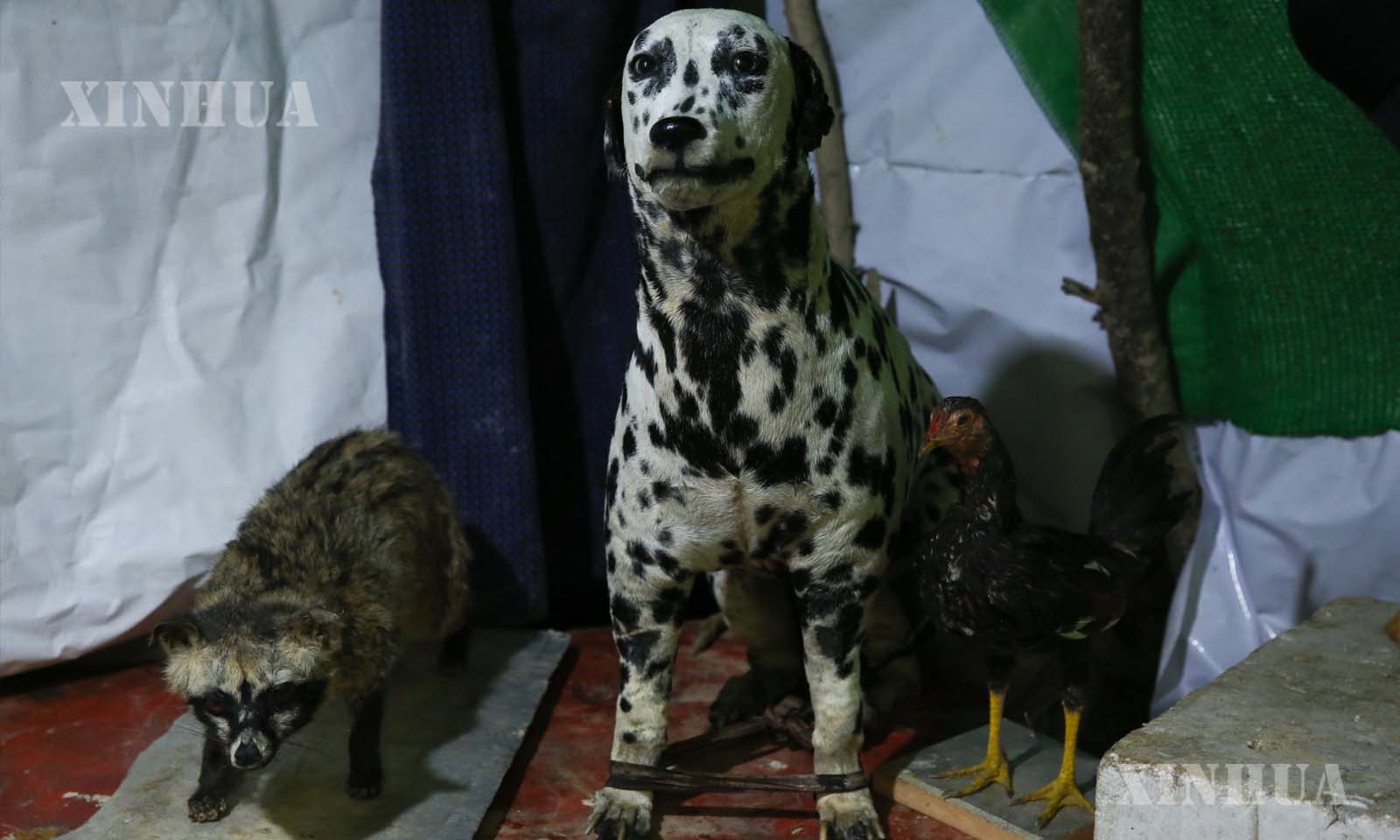
မြန်မာနိုင်ငံ ရန်ကုန်မြို့ရှိ သားရေခွာရုပ်လုံးသွင်းအလုပ်ရုံတွင် ရုပ်လုံးသွင်းထားသော တိရစ္ဆာန်လေးများကို ၂၀၂၄ ခုနှစ် ဩဂုတ် ၁၈ ရက်က တွေ့ရစဉ် (ဆင်ဟွာ)
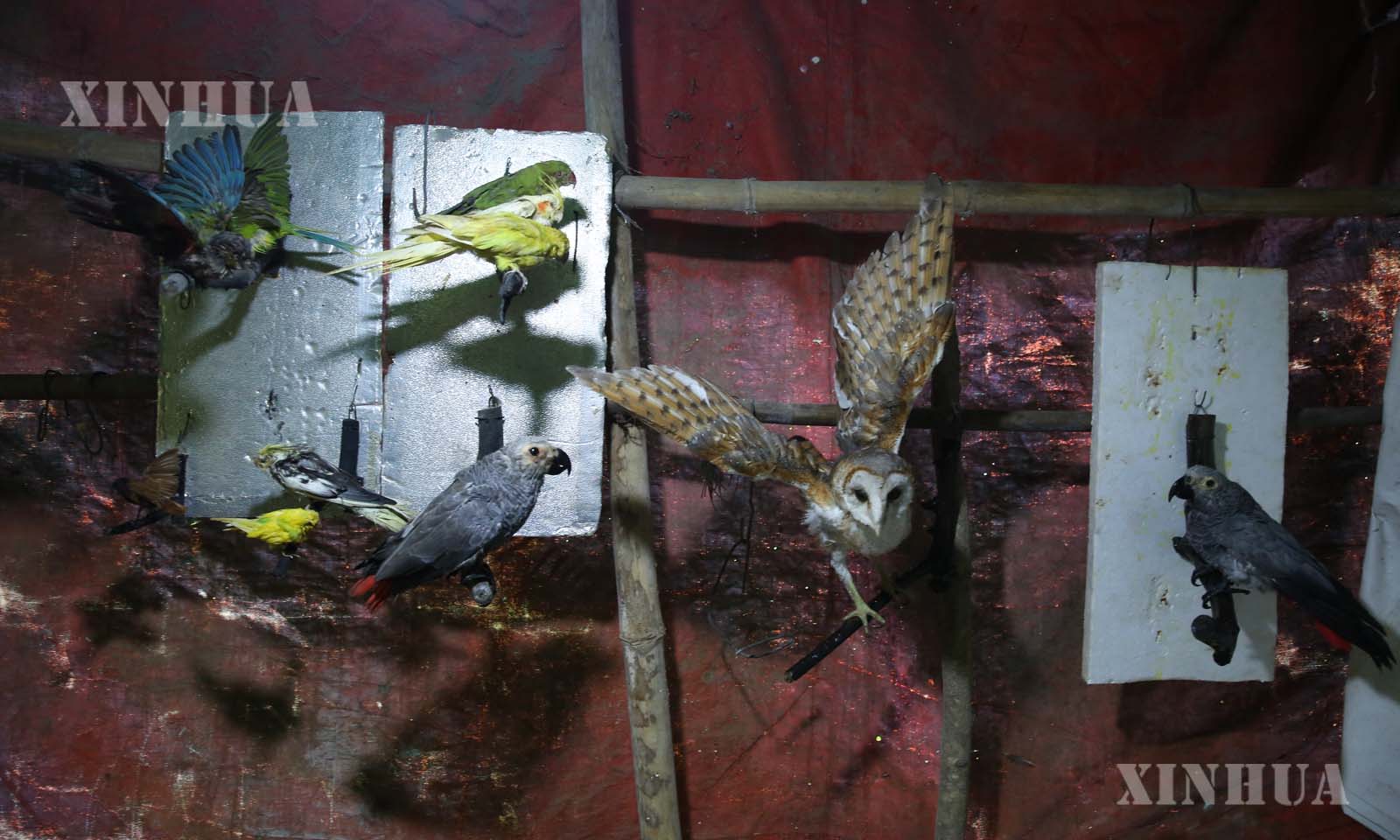
မြန်မာနိုင်ငံ ရန်ကုန်မြို့ရှိ သားရေခွာရုပ်လုံးသွင်းအလုပ်ရုံတွင် ရုပ်လုံးသွင်းထားသော တိရစ္ဆာန်လေးများကို ၂၀၂၄ ခုနှစ် ဩဂုတ် ၁၈ ရက်က တွေ့ရစဉ် (ဆင်ဟွာ)
………………………..
(English Version)
Calling new generation to sustain Myanmar’s rare taxidermy craft
YANGON, Aug. 19 (Xinhua) — In a quiet corner of Yangon, hidden among the bustling streets, stands a modest tent filled with bodies of dead animals that were preserved through taxidermy. This is where U Myo Naing, 52, one of Myanmar’s few taxidermists, has kept this art alive for over 25 years.
“Taxidermy is the art of preparing, stuffing, and mounting the skins of deceased animals. I learned the art of taxidermy from my teacher, U Paw Than,” U Myo Naing said.
“In Myanmar, taxidermy is a rare and endangered art. I continue to practice it because I want to pass it on to the next generation and preserve this art in our country,” he added.
“I am inviting hobbyists who want to learn taxidermy. There are a few people who learn this art, but no one completes the course. Most of them study this as a hobby, not for a living. So, we need new generations to preserve this rare craft,” he said.
Phyo Arkar, who has devoted over four years to studying taxidermy, said, “I am drawn to this rare art form and see its value in preserving both rare wildlife and beloved pets in lifelike form, even after they have passed away. Although I am still exploring how to make a living from it, I believe the art is highly beneficial for pet lovers.”
Ko Pyae, who has studied taxidermy for about a month, said, “Though interested in the art, I don’t have any plans to earn from it. I think it can still help pet lovers in some way.”
According to U Myo Naing, “I typically work on two or three animals for taxidermy in a month, though sometimes, there are no offers at all. Despite this, I continue this work because I want to preserve this art for future generations.”
“Currently, there are only two main taxidermists in Myanmar, including myself. I give courses at universities to promote this art and encourage enthusiasts to preserve this rare craft,” he said.

